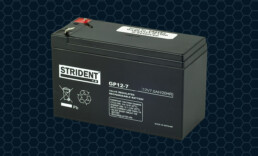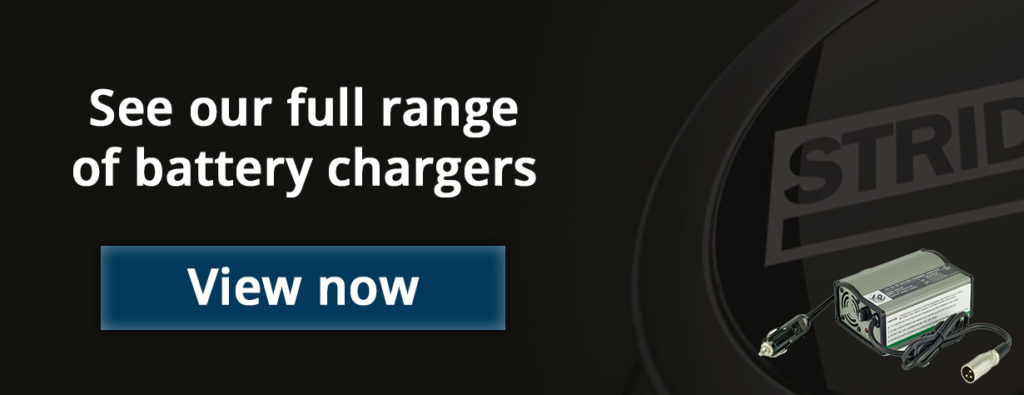What makes a great mobility scooter tyre? See our short animation.
At Strident we have a wide range of hard-wearing, reliable, mobility tyres to suit many of today’s equipment needs. We hold large stocks of tyres for mobility scooters in both solid and pneumatic which have many benefits which are listed below and can be seen in the video below.
When searching for a great mobility scooter tyre as about the following:
- Designed for longevity. If you have ever had to choose tyres for a car then you'll know that some are cheap and cheerful whilst others are designed for longevity. Look for a tyre that is designed to last.
- Quality Assured. The tyres of your mobility scooter or powered wheelchair are crucial to their operation. Ask what quality approval scheme any tyres that you are being recommended come under.
- Durable Rubber: If tyre rubber is too hard there is a potential safety risk as the level of traction may be lower when on the move. Take a good look at any tyres and touch them to see if the rubber is flexible and 'tacky'.
- Comfortable Ride: If you get all of the above product features with a tyre purchase, then you have every chance of enjoying a comfortable and safe ride.
If you are looking for a great quality tyre or want to find out more about the benefits of Strident Traction Mobility Tyres then please do visit our Traction product page.
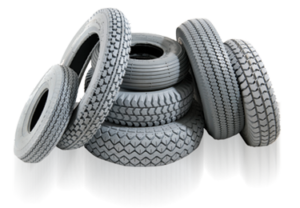 We've also got a recent blog on how the state of your mobility scooter tyres can affect the performance of your scooter battery. Read that article by clicking here.
We've also got a recent blog on how the state of your mobility scooter tyres can affect the performance of your scooter battery. Read that article by clicking here.
Strident now offer same day dispatch for mobility products up to 3.30pm
Better service for your mobility and health customers with less stock
 Have you considered the effect on your business if you could speed up your service turnaround yet not have the cost of increased stock holding? We've heard our partners ask if there is anything we can do as their main battery suppliers to help.
Have you considered the effect on your business if you could speed up your service turnaround yet not have the cost of increased stock holding? We've heard our partners ask if there is anything we can do as their main battery suppliers to help.
Strident has found in our discussions with the mobility and health sectors that quick and reliable deliveries are key to our partners. As such, we are pleased to announce that we can now offer you same day dispatch up to 3:30 pm at no extra cost.
Would this help your company's goals of better service levels and lower stock levels?
Please do contact us if you feel you could benefit from this enhanced service. Simply complete the form below and we'll get in touch.
24v 5Amp Mobility Scooter Battery Charger Review
If you are looking for a 24v 5Amp mobility scooter battery charger, then here is a review of one of Strident Batteries' most popular products - the Strident CHE Charger CHE24-5. This is one of the top selling battery chargers in the Strident range and is recognised by mobility and disability equipment installers and maintenance companies for some industry leading features.
But aren't all 24-volt battery chargers the same?
Are all battery chargers the same? We don't think so - and given the vital role of a mobility scooter battery charger, we believe users need to have peace of mind that they can get the very best from their batteries. In addition to the quality of the battery itself, the battery charger plays a key role in achieving optimum battery performance.
What does a 24-volt battery charger need to offer in a mobility or medical setting?
The main factors that relate to the requirements for mobility and medical batteries:
1. Correct levels of charge need to be applied to every stage of recharging
2. Eliminate any risk of gassing caused by overcharging
3. The recharging process doesn't damage the battery plates
How does Strident’s 24v 5Amp scooter battery recharger meet those requirements?
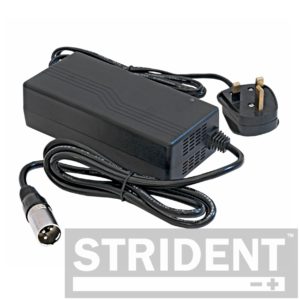
All Strident Battery chargers use an intelligent three-stage charging process in order to meet all of the requirements listed above. The three stages are:
Stage 1: Bulk Charge
Where charging current is set to the maximum safety level. Continuing until the voltage has increased to 80 – 90% of the full charge level.
Stage 2: Absorption Charge
The charging voltage remains constant, whilst the current reduces due to the increase in internal resistance. It is during this stage that the charging voltage is at its highest.
Stage 3: Float Charge
Once the battery has reached optimum charge level this final stage helps to increase the longevity of the battery because the charging voltage and current is significantly reduced which maintains the battery at peak charge. Through the units intelligent monitoring of the battery condition this final and critical stage reduces the risk of gassing and minimises the possibility of self-discharge.
Through utilising our range of chargers you can be assured that your batteries are being charged, conditioned, and maintained to ensure peak performance and longevity.
Strident Service on top of the technology
In addition to our range of batteries, chargers, and traction products, Strident provides a very high level of service. If, for example, you would like any help identifying exactly the right product, then just call us on 01362 300102. One of our experts can talk you through all the options.
Please visit our Product page for details and enquiries or in order to arrange a callback.
Which? Publish Their Latest Best Buy Guide to Mobility Scooters
If you are currently exploring the purchase of a new mobility scooter or looking at a replacement or upgrade, take a look at Which?’s latest best buy guide.
Like many of their excellent reports, they point out that it is not always the most expensive mobility scooter that gets the top ratings from experts and consumers.
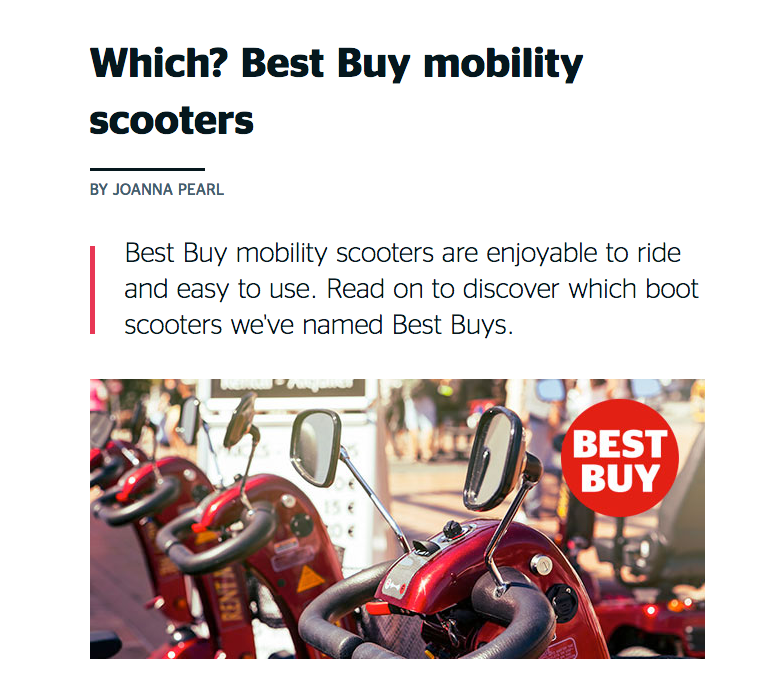
Experts and Users involved
For this new review, Which? has had an independent expert panel of ergonomists, occupational therapists and disabled scooter users test a series of mobility scooters. The panel has tried to include everything you would be likely to do with the scooter in real life use whether that is moving around obstacles or getting up slopes. In particular, they have been looking at:
- Ride quality
- How easy a scooter is to fold or dismantle
This reflects the frequent challenge to get the balance right between these 2 essential elements of scooter use – weight and comfort. In the tests, they have including the process and effort involved in getting scooters in and out of cars.
Considerations when comparing Mobility Scooters
They have also rated some of the other key considerations that relate to the purchase and use of Scooters.
- Preparing to ride. Which? has looked at how you can adjust parts of the scooter (e.g. seat, armrests etc.) to make the scooter as comfortable and supportive as possible.
- Setting off. How easy is it to start the scooter and pull away safely and with the least amount of fuss
- Indoor riding. How manoeuvrable are the scooters indoors
- Outdoor riding. Can the scooters cope with slopes, rough surfaces and kerbs
- How easy it is to pull the scooter along when not in use
Strident offers support for all brands of Mobility Scooters
Whichever mobility scooter you end up with, the battery, the charging process and tyre maintenance will be key elements of long-term ownership. Strident are leaders in Mobility Scooter batteries, chargers and tyres.
Strident’s battery technology combines performance with dependability and we can answer any questions you have regarding the replacement or upgrading of a battery on your mobility scooter.
We also carry an extensive range of battery chargers and specialist mobility scooter tyres in our ‘Traction’ catalogue.
Choosing the right tyres
A good mobility scooter can only perform at its best if it’s using quality parts; and here at Strident Innovations we’ve talked a lot about quality batteries lately. Equally important however, is a good choice of tyre.
But how do you choose the right tyre for your scooter?
First and foremost, they need to be the right size. There’s a huge volume of tyre sizes out there for various types of scooter, and the wrong size either simply won’t fit, or could be dangerous to ride on.
The easy way to tell what size you need is by taking a quick look at the sides of your existing tyres. Typically, the tyre dimensions will be embossed on here, or may be located on the inside of the tyre itself. Make a note of these dimensions and you should be able to spot the same sizes in a supplier catalogue or online store.
Do bear in mind that some models of scooters use different sized tyres on the front end, to those on the back.
Once you’ve got a handle on what size you need, you’ll likely come across a choice between solid tyres, or air filled/pneumatic ones.
Which of these you choose, tends to come down to personal preference.
Air-filled tyres have the advantage for comfort, as they absorb impacts and make for a less bumpy ride.
They are more prone to puncture however, and must be kept at a consistent pressure. So generally speaking, they require a higher level of maintenance.
Soild tyres on the other hand, cannot be punctured, and can’t deflate, as there’s no air inside to escape. This does make them excellent low-maintenance choices, but at the cost of a potentially more comfortable ride.
Here at Strident, all of our tyres (regardless of type) are carefully sourced to ensure they meet the highest quality control standards. Only products that demonstrate a proven, high level of performance and integrity, become part of our range of mobility products.
For additional advice on choosing mobility scooter tyres, don’t hesitate to ask the helpful team here at Strident. Our knowledgeable team is happy to answer any questions and assist you make an informed decision.
You can get in touch with us directly on 0845 555 5511, or message us via the contact page. For more information on any of our products, please download one of our brochures.
Maintaining Your Scooter Batteries – Our Top Tips
It’s always a sensible idea to invest in good quality batteries for your mobility scooter. But once purchased, properly maintaining those batteries should be an important practice. You can expect most battery products to last around a year before they’re in need of replacement. But with the following tips, they could last much longer - providing maximum value-for-money and reliability.
Don’t overcharge them
Overcharging is one of the most common causes of shortened battery lifespans. Mobility scooter batteries will tend to reach capacity (from empty) over the course of around 8 hours. So if you charge your batteries overnight, be sure to disconnect your charger in the morning once the batteries are full. Try and get in the habit of connecting and disconnecting your charger at the same times each day, to get into a proper routine. Chargers with built-in overcharge protection (like the ones here) can also help to negate this issue.
Run new batteries down
Every set of new batteries you purchase should be charged up to full and then run down a few times before use. This helps them to operate optimally and provide accurate readouts of their current charge level.
Make sure you’re using the correct charger
This should be obvious, but incorrect charger use can be especially harmful to your batteries’ longevity. Make sure that you use a charger recommended by your battery’s manufacturer, or one specified in your product’s manual. Take a look at our page on selecting the best charger for your battery, for a few more pointers.
Drain and charge them when they’re not in use
If you don’t use your mobility scooter regularly, your batteries won’t get used (or charged) as often as they should. Inactivity can be damaging to the battery’s chemicals, so be sure to drain and charge your batteries at least once every six weeks.
For more tips on battery maintenance, or for advice on purchasing new batteries for your scooter, don’t hesitate to ask the team here at Ivanhoe.
With over 15 years of direct experience with battery power, our knowledgeable team is happy to help you make an informed decision.
You can get in touch with us directly on 0845 555 5511, or message us via the contact page. For more information on any of our products, please download one of our brochures here.
Advantages of Lead Crystal Batteries
Those of you who’ve shopped online for batteries before, are probably familiar with AGM, Gel and small-cell batteries. But you may not have come across Lead Crystal Batteries as possible power solutions.
But what exactly are lead crystal batteries, and what makes them worth considering for your application?
There are a number of great benefits to these power sources, which make them an excellent choice in a number of situations. As a result, they’re commonly used today in telecommunications, wind and solar power, healthcare, manufacturing and electric vehicles.
Firstly, they can be charged faster than most conventional batteries and be safely discharged to 0 volts without being put under stress. They can also be discharged more often and will comfortably operate between extreme temperatures of -40 to 65 C (making them great for regular use in harsh environments.) And incredibly, they require no extra ventilation or cooling to operate under these conditions.
They’re also much safer than many other battery types in both their day-to-day use and in the long term. As they use less acid and no cadmium or antimony, this reduces the risk of harmful leakage, and they’re up to 99% recyclable depending on the make and model.
This reduced risk even results in lead crystal batteries being classified as non-hazardous for transport, reducing potential issues that might arise when travelling internationally.
The batteries’ overall resilience means they boast a float service life of up to 18 years and can be stored for up to two years without needing to be refreshed or recharged.
If you’re unsure if lead crystal battery power is right for your product or application, don’t hesitate to ask the team here at Ivanhoe. With over 15 years of direct experience with battery power, our knowledgeable staff are happy to help you make an informed decision.
You can get in touch with us directly on 0845 555 5511, or message us via the contact page. For more information on our products, including charging accessories, you can download one of our brochures here.
Testing Mobility Scooter Batteries – Pre-Holiday Checks
For most of us, preparing to go on holiday can be a stressful experience.
Between sorting accommodation, packing clothes and finding travel documents; there are plenty of potential headaches to contend with. But testing the batteries on your mobility scooter needn’t be one of them.
Ensuring they’re in top condition before the trip should be an essential check on your pre-holiday to-do list. It’s a quick and simple process and one that could prevent a tricky situation while you’re away.
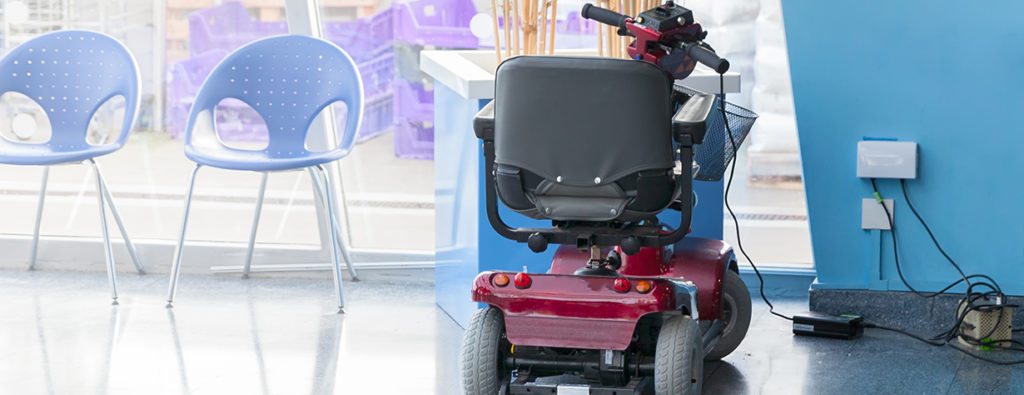
Testing Mobility Scooter Batteries - Your Quick Guide
Your scooter’s battery indicator can be a helpful tool for checking more than just its current charge level. Typically, these take the form of a set of LEDs or a needle indicator, and will vary in location depending on your scooter’s model.
With the batteries fully charged, press or push the levers that make the scooter run. If the indicators decrease immediately, this could mean your batteries are weak and in need of replacement.
Another method for checking is to drive your scooter up a gradient equal to around 75% of its capability. Take a look at the indicator’s level as you begin to move up the slope. If it drops from full to around the halfway mark (or lower), this is another indication that the batteries may need replacing.
If everything’s in working order, then great! Your batteries are ready for the trip. The next essential check on your list should be the battery charger.
Testing your battery charger
Firstly, you’ll need to know your scooter’s maximum drive distance, which can be found its manual.
Plug your charger in overnight, and the following day, take your scooter for a ride. Drive until the scooter’s drained and make a note of your travelled distance. Now charge the batteries again overnight and repeat. So long as you reach approximately the same distance each day, then you know the charger is working effectively. If you find that you’ve not been able to go as far from one day to the next, the charger may be faulty and in need of replacement.
If you suspect a fault but aren’t certain, we’d recommend getting in touch with your nearest mobility retailer, where they can offer professional testing.
If there are no issues with either your batteries or charger, you should be good to go. Bringing spares is always a sensible idea (especially for longer trips.) And remember that if you’re flying abroad, you’ll need to notify your airline of the equipment you're travelling with ahead of time.
If you need any extra help with testing mobility scooter batteries, or are in need of new ones, you can get in touch with the experts here at Ivanhoe.
With over 15 years of direct experience with battery power, our knowledgeable team is happy to assist in choosing a reliable, long-lasting product.
You can call us directly on 0845 555 5511, or get in touch via the contact page.







